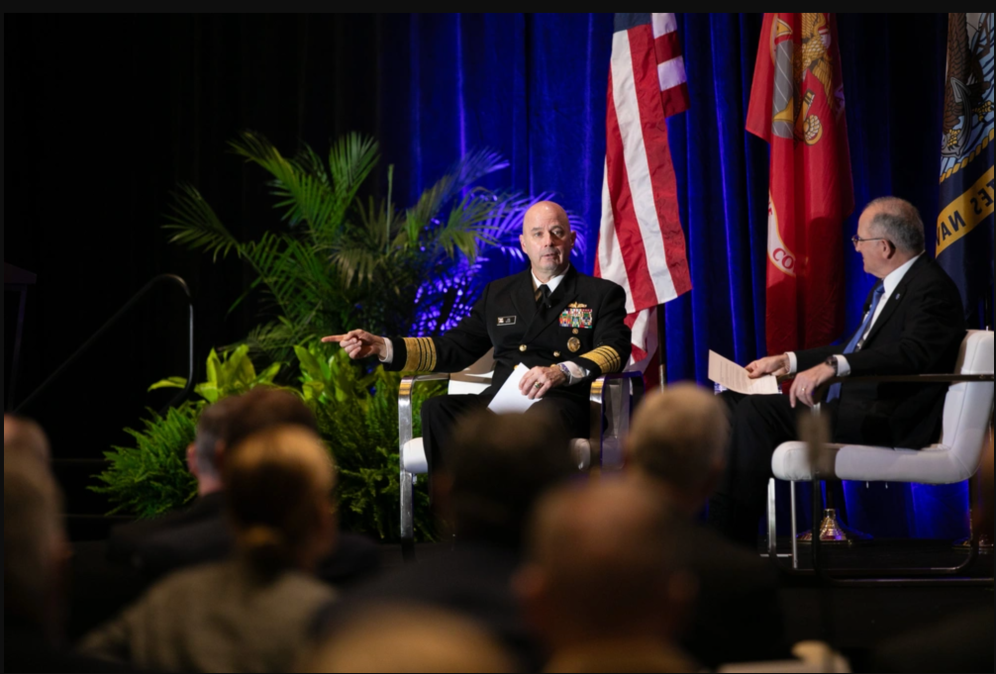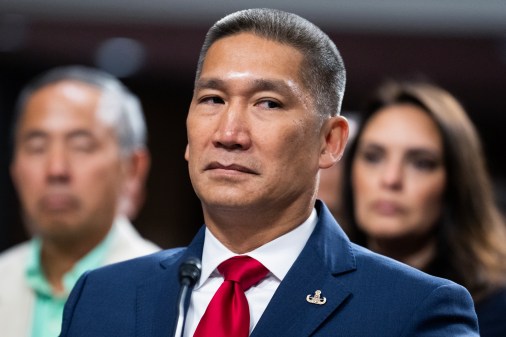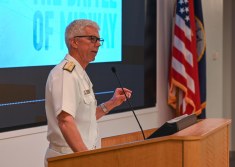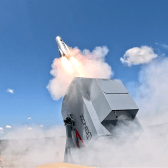How the Navy’s vision to enhance readiness and lethality by 2027 hinges on technology

NATIONAL HARBOR, Md. — The Navy’s high-stakes plans to integrate hundreds of crewed and uncrewed maritime vessels and link up that future hybrid force via Project Overmatch are essential to bringing to life its new vision to expand readiness and lethality by 2027 against a backdrop of evolving threats, the acting chief of U.S. Naval operations said Monday.
Adm. James Kilby shared a status update on that work and shed light on some of the sea service’s associated near-term, technology-enabling efforts during a media roundtable at the Navy League’s Sea-Air-Space forum.
“One of our goals — one of our seven targets — is this hybrid fleet [with] robotic and autonomous systems,” Kilby explained. “The challenge for us is to really robustly lay out a roadmap to get there. We’ve had some fits and starts there, so we must do better. Our initial focus is 2027 though, [for a] capability that will help us in the Pacific.”
Last year, then-CNO Adm. Lisa Franchetti unveiled a list of seven “Project 33 targets” to accelerate to enhance the Navy’s long-term advantage and ensure readiness for a possible war with China by 2027. President Donald Trump fired Franchetti in February, but as Kilby suggested, the Navy continues to pursue those immediate modernization aims under his leadership and while waiting on a new nominee to be named.
He said personnel are currently moving to deploy a unified network of unmanned and manned platforms “in a meaningful way.”
“The MQ-25 is the first unmanned aircraft to integrate with the air wing. Beyond that, once we do that, I’m looking at sensors, I’m looking at electronic attack, possibly a loyal wingman concept — but I also have to have unmanned surface [capabilities] helping me in that fight, as well,” Kilby noted.
He acknowledged that while the Navy is pursuing a range of activities to boost global readiness and enhance platforms’ maintenance and efficiency at shore and sea, its force and arsenal are simultaneously in high demand all over the world. Kilby pointed to the Nimitz and Vinson Carrier Strike Groups, which are conducting deterrence and other operations in the Indo-Pacific region, as well as the P-8A Poseidon maritime surveillance aircraft and a guided missile destroyer supporting Northern Command on the Trump administration’s new U.S.-Mexico border missions.
“Over the past 18 months, our sailors in the Red Sea have successfully countered hundreds of Houthi missiles and [unmanned aerial vehicles]. We have had over 20 ships that have operated in the Central Command area of responsibility for this, and today, the incredible sailors of the Harry S. Truman Carrier Strike Group are there carrying on that effort,” the acting CNO said.
As that conflict continues to disrupt commercial shipping and place sailors’ lives at risk, Kilby said he’s increasingly concerned about the Navy’s lack of options to more economically counter that threat, and America’s munitions industrial base.
“As the former [deputy chief of Naval operations for warfighting requirements and capabilities, or N9], I was focused on a high-end laser, 500 kilowatts to 1 megawatt. And I have regret for that — that I had not been thoughtful enough to think about the UAV threat, where I think a much lesser-power weapon would have done what we needed to do,” he said.
The Navy’s secretive Project Overmatch marks another key element of its future warfighting capabilities and overarching intent to prioritize lethality, per Trump’s recent orders.
That initiative is a major piece of the Navy’s contribution to the Pentagon’s Combined Joint All-Domain Command and Control (CJADC2) operational concept and will be crucial to the U.S. and its allies’ joint tactical network of the future.
“The classic example of Overmatch is I want to be able to communicate across every single modality I have at sea, based on prioritization of message. Comms-as-a-service and software-defined radios are a piece of that as well. So, that effort continues,” Kilby told DefenseScoop.
“This ability to communicate in a more effective manner at sea makes me more lethal, where I’m not having to wait for a certain prioritization of messages to go out — the system just understands the quickest means to do that and sends that message,” he explained.
For most of Kilby’s career, Navy forces have been able to conduct power projection, or sail anywhere in the world to carry out orders. But contemporary network advancements are introducing nascent challenges and making it easier for adversaries to locate U.S. forces’ whereabouts.
“Overmatch, and [the fight from the maritime operations centers], and the mission control of my strike group is what I need to do to be able to have access into that environment,” Kilby said.
Earlier this year, the Project Overmatch team unveiled its first-ever formal project arrangement with the Five Eyes intelligence-sharing alliance — Australia, Canada, New Zealand, the U.K. and the U.S.
“Certainly we need to work with our allies across the board here, and I’ll meet with several of them during this conference,” Kilby told DefenseScoop during the roundtable.
Naval Information Warfare Systems Commander Rear Adm. Seiko Okano was recently tapped as the newest lead for Project Overmatch.
Kilby confirmed he’s impressed with her early work in this role, including recent moves to target readiness across the maritime operations centers and from the strike group commanders in new and noticeable ways — and largely by handling data differently.
“She’s been critical in helping us with the unmanned surface vessels, and communicating with C2 and command and control, and using artificial intelligence to do things like automatic target recognition, which are important for those targets, and to have that data set updated — so I see it continuing and only growing larger as we move forward,” he said.






